Tenerife - largest of the Canary Islands
Tenerife is the largest of the Canary Islands and is a great place to travel. British, Nordic and German tourists come in their tens of thousands every year to visit its spectacular beaches and lively nightlife. It is also very popular among holidaymakers from the Spanish peninsula, especially during Easter time. It offers lush forests, exotic fauna and flora, deserts, mountains, volcanoes, incredibly beautiful coastlines and spectacular beaches.
Regions
The entire island is a Spanish province named Santa Cruz de Tenerife, which leads to inevitable confusion with the capital city Santa Cruz de Tenerife. The island is divided into 31 municipalities, belonging to three regions with their own distinct climate, history, and appeal.
{{Regionlist |region1name=Metropolitan region |region1color= |region1items=Anaga Rural Park, Santa Cruz de Tenerife, La Esperanza, San Andrés, San Cristóbal de La Laguna, Taganana, Tegueste |region1description=The northeast of the island is the most densely populated, and home to the only 2 cities on Tenerife, capital city Santa Cruz de Tenerife and historic capital San Cristóbal de La Laguna with is a . The eastern tip of the island is covered by the Anaga Rural Park, a mountainous and very rural area.
|region2name=The north |region2color= |region2items=El Sauzal, Garachico, Icod de los Vinos, La Orotava, Puerto de la Cruz, Teide National Park, Teno Rural Park |region2description=Due to the influence of the northeastern tradewinds, the northern coast tends to be cooler, with somewhat unstable and cloudy, springlike weather. It is home to many of the islands cultural and historic treasures, and the El Teide volcano.
|region3name=The south |region3color= |region3items=Candelaria, Costa Adeje, El Medáno, Granadilla de Abona, Guía de Isora, Güímar, Los Cristianos, Los Gigantes, Masca, Playa de las Américas, Santiago del Teide, Vilaflor |region3description=The south coast has a hot arid climate, and it was not until the late 19th century that these areas started development. If you are looking for beaches and nightlife, the southern coast is the place to go, as sunshine is almost guarenteed. Otherwise, this is the least interesting part of the island. It lacks the heritage and charm of the north, and most of the towns are residential, modern concrete constructions with little architectural appeal. There are however some picturesque towns to discover in the east (Güímar, Candelaria) and Vilaflor on the southern slopes of El Teide. }}
Cities and towns
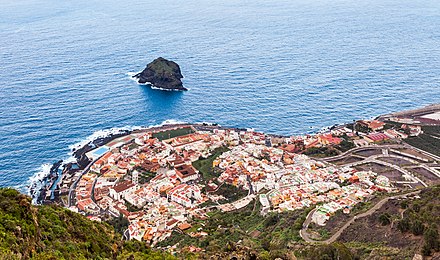
Metropolitan region
- Santa Cruz de Tenerife – The capital
- La Esperanza – A town, in El Rosario municipality, founded by Castillian conquerors
- San Andrés – One of the oldest settlements of Tenerife with a large white sand beach, artificially created with the help of Sahara sand
- San Cristóbal de La Laguna – A
- Taganana – A traditional town in the Anaga Rural Park with a rich tradition in sugar cane and wine cultivation
- Tegueste – Guanche era colonial town, famous for its wines
The north
- El Sauzal – A town surrounded by rolling hills with vineyards
- Garachico – A harbour city, partially destroyed and rebuilt after a volcanic eruption in the 18th century with a large area of rock pools and swimming pools near the sea
- Icod de los Vinos – Famous for its millenary Drago tree, local wines, and the largest volcanic cave in Europe
- La Orotava – A stately and beautiful city
- Puerto de la Cruz – A laid-back, more family-friendly resort with the Loro Parque Zoo
The south
- Candelaria – Known for its basilica and pilgrimage
- Adeje, Costa Adeje, Playa de las Américas and Los Cristianos – Adeje, Costa Adeje, Las Americas and Los Cristianos together form the most popular tourist resort with beaches and all tourist amenities
- El Medáno – A laid back, alternative haven, and one of the windsurfing capitals of the world
- Granadilla de Abona – A former Guanche kingdom and home to the best restaurant of Tenerife and the nearby Paisaje Lunar nature monument
- Guía de Isora – A desert town known for its greenhouse cultivation of tomatoes, bananas, and flowers
- Güímar – A town known for its lava rock pyramids, the badlands and the impressive Ventanas de Güímar
- Los Gigantes – Popular with tourists and locals, and great hub for hiking adventures into the Los Gigantes canyons and tunnels, Chinyero and the almond flower trail from Santiago del Teide, Teno Rural Park (with hikes to Punta de Teno from Teno Alto), and Masca
- Masca – A picturesque mountain village in the Teno Massif overrun by tourists no matter what time of the year
- Santiago del Teide – A desert town and weekend hotspot straddled between Teide National Park and the Teno massif
- Vilaflor – An off-the-beaten-track place that has largely retained its originality, and a popular place to spend the night for those seeking to climb the volcano
Other destinations
- Teide National Park – A surrounding El Teide, with 3,715 m the highest peak on Spanish territory, an active volcano, and most visited natural wonder in the country with more than 4 million annual visitors.
- Anaga Rural Park (Macizo de Anaga) – A protected area redesignated from natural park to rural park.
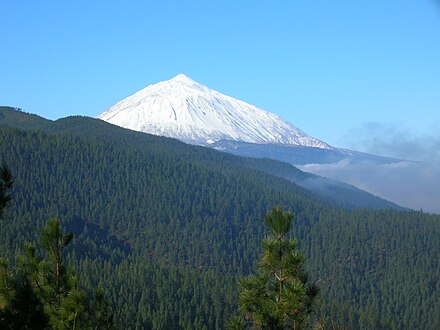
- Corona Forestal Natural Park – A protected environmental zone with an area of 410 km², making it the largest protected natural area of the Canary Islands. It extends from ca. 300 m above sea level to the slope of Mount Guajara at 2,718 m. Most of the area is covered by Canarian pine forests.
- Teno Rural Park – One of the 3 volcanic formations that make up Tenerife, in the northwestern part of the island. The massif is 5 to 7 million years old and furrowed by deep ravines. It ends abruptly in a series of high cliffs that plummet over the sea known as Los Gigantes. The park spans an area of 80 km² and is known for its basaltic lava flows and diverse flora resulting from its microclimate.
Understand
Tenerife, the largest island of the Canary Islands archipelago and home to ca. 900,000 inhabitants, is a fantastic holiday destination. The island has a rich cultural history dating back thousands of years when it was populated by the Guanche aborigines, and colonial architecture dating from the 1497 Spanish conquest of the island can be admired in many of its modern towns an cities. Historic capital city San Cristóbal de La Laguna is an architectural gem on its own, and its centre is one of the island's two s.
In addition to its cultural assets, Tenerife also has many natural treasures. The most famous of which is Teide National Park, the island's other UNESCO World Heritage site, and home to Spain's tallest mountain El Teide, also the world's 3rd highest volcano (after the Hawaii volcanoes). It is the oldest and largest protected area of the Canary Islands, and receives ca. 3 million visitors annually. The north of the island is also a natural reserve, the Anaga National Park.
A poor, banana-growing region in past decades, Tenerife has been brought up to European living standards since the arrival of mass air travel in the 1960s, which brought industry and millions of tourists each year. Over the decades this has led to many complexes and houses being built, making parts of the island highly urbanized. While part of the EU for political purposes, the island remains outside its customs and VAT area, making high tax goods such as tobacco and alcohol cheaper than elsewhere in Europe. Because almost all goods must be imported, food and clothing in particular are more expensive than on mainland Europe.
Many of the young tourists hang out on the south of the island with older and family tourists choosing Puerto de La Cruz and its environs. On the south side there is consistent summer, little to no wind, and pretty much perfect beach-weather for much of the year though there have been rare instances of cool to cold weather in the Jan-Feb period. Also expect some very wet days for that time of year though most days will still be sunny. There are plenty of hotels, activities and British food and drink.
On the north side of the island you will find more green and vibrant local culture. There is a more Spanish year-round springtime feel. The weather fluctuates a bit more here, but is also mostly pleasant though not as hot as the south.
In between the north and south of the island sits Spain's tallest peak, the barely dormant volcano El Teide (3,715 m above sea level). Tours previously allowed people into the crater, but tourists are no longer allowed into the crater for safety reasons.
Climate
The Atlantic ocean absorbs heat in summer and releases it in winter, granting Tenerife fairly constant temperatures throughout the year, with typically less than 10° difference between summer and winter. In combination with its proximity to the equator, this results in mild temperatures from fall to spring, and hot temperatures in summer (June to September). Fortunately the ocean winds cool the island down, and at higher elevations the temperatures are very mild even when the low laying parts of the island succumb under a scorching heat.
Tenerife receives most of its precipitation during the winter months (November to February), which always falls as rain at sea level and as snow on El Teide.
Talk
The native language is Spanish, more specifically Canarian Spanish. In this local dialect a soft 'c' is pronounced as 's' rather than as 'th' on the Spanish mainland, so cinco (five) is 'sinko', not 'thinko'.
Despite of the prevalence of tourists on the island, English and other European languages are not understood by many locals, even in larger cities such as La Orotava and San Cristóbal de La Laguna, but rather only spoken around tourist attractions such as El Teide. Staff in hotels and restaurants generally know enough basic English to take your order or help with problems. Many restaurants have a multilingual menu (Spanish/English/German). In smaller towns such as Santiago del Teide or Vilaflor, understanding of English is very limited and you'll need to rely on your own translation skills.
Santa Cruz de Tenerife is the capital city and, despite its importance as a seaport, has a very local demographic; languages other than Spanish are therefore rarely heard in the streets.
Get in
As with any small island, Tenerife's ecosystem is vulnerable and is already suffering from the consequences of invasive species (both fauna and flora) introduced to the ecosystem by travellers. Examples are the large prickly pears cactus and agave, both originating from the Americas, but nowadays so common on Tenerife that they are often mistaken for endemic species. Among invasive animals are hedgehogs and termites. Few of them have natural enemies on the island, allowing them to replicate rapidly and taking over the entire ecosystem.
When travelling to Tenerife, carefully check luggage for stowaway seeds and insects (including eggs and larvae). This is particularly a risk when travelling from a similar climate, giving stowaways a high chance of survival. If found upon arrival, dispose of them through incineration (can be as simple as burning with a lighter). If you believe exotic fauna or flora has already escaped, alert authorities immediately.
Tourists are often considered to be among the more harmful invasive species, displacing local fauna and flora, and consuming massive quantities of fresh water. Consider the scarcity of fresh water on the island during your stay, and use rain water to wash clothes or flush toilets if your accommodation allows you to do so.
By plane
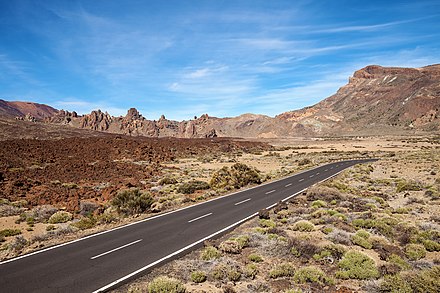 As an island the usual way to arrive is by air. There are two airports, Tenerife South (Reina Sofia) near Los Cristianos and Tenerife North (Los Rodeos) by San Cristóbal de La Laguna. Titsa buses run from both airports to other towns, though you may have to change routes. They stop around midnight and start again around 05:00-06:00.
As an island the usual way to arrive is by air. There are two airports, Tenerife South (Reina Sofia) near Los Cristianos and Tenerife North (Los Rodeos) by San Cristóbal de La Laguna. Titsa buses run from both airports to other towns, though you may have to change routes. They stop around midnight and start again around 05:00-06:00.
- Tenerife Norte (Los Rodeos), 28.4874°, -16.3459°. (IATA: TFN) Most services into this airport are from the mainland of Spain. Iberia offers several flights a day from Madrid (although normally quite expensive), Air Europa also flies from Madrid; Air Europa and Vueling offer flights from Barcelona, Malaga, Valencia and Seville to Tenerife North. In addition to these flights, Binter Canarias operates a fleet of turboprop aircraft flying to the neighboring Canary islands. There are international flights to/from London (LHR), Helsinki, Rome, Agadir, Casablanca, and Funchal. This airport is the older of the two on the island and Tenerife South Airport was built in part due to persistent fog problems which also played a role in the Tenerife Airport disaster of the 1970s when two 747s collided on the runway. There is a monument to commemorate the disaster in San Cristóbal de La Laguna. 2016-12-19
- Tenerife Sur (Reina Sofia), 28.0476°, -16.5776°. (IATA: TFS) Named after the previous Queen of Spain this is by far the busier of the two airports. Flights from various UK airports are available through EasyJet, Ryanair, Jet2, and TUI Airways. Flights from the Spanish mainland are offered by Iberia, Air Europa, and Vueling. There are also flights from Germany offered by Ryanair, Eurowings, and Condor among others. There are many other destinations apart from those mentioned here. 2016-12-19
By boat
Trasmediterranea run a weekly ferry from Cadiz in Spain which takes two days.
For more information on available ferry companies, times and prices between the islands, see Canary Islands#By boat 2.
Get around
By car
If you are in the possession of a driver's licence, a rental car is the best option for discovering the remote locations on the island—see Canary Islands#By rental car for more information.
Driving
Most of the road network is in good shape, although roads in the mountains may be less well maintained. Fallen rocks blocking the road are a recurring hazard, especially on roads carved into the mountain side. The highways around the island are toll-free and mostly limited to 120 km/h. Everything called "Calle" or "Camino" in the rural and residential areas is likely to be very narrow and potentially steep and curvy.
Especially during the weekend, many people come out with their bicycles and motorbikes and use the island's roads for extensive leisure trips. Be particularly cautious and mindful then—everyone wants to enjoy their time.
Navigation
The road network is under active (re)construction. As of 2019, your rental car's built-in navigation system may still be missing some of the newer main roads. Google Maps appears to be fairly complete in terms of major roads. OpenStreetMap provides very complete maps of the islands roads, hiking trails and other points of interest.
When planning excursions and trips, keep travel times in mind. Satellite navigation systems usually assume you'll be travelling at the speed limit, which is unrealistic on most of the road network. An actual average speed of 30 km/h or below is realistic for tourists, although locals who know the road network well can be seen racing up and down mountains occasionally.
By public transport
A ten+ (ten mas) travel card (€2 deposit) is a good idea if you intend to spend some time travelling on the buses and trams in Tenerife. It can be charged with any amount of €2–100, and provides decent discounts over cash payments. It can be bought and recharged at more than 500 locations across the island—besides the bus stations of course.
In addition, the ten+ card can be charged with a travel package (using the money on the card), which allows for unlimited travel for a number of hours or days: 24 hr for €10, and 7 days for €50–see website. However, unless you are planning to use buses more that 4-5 times a day and for longer distances, these packages often don't really make sense, considering the steep discounts the card already provides. The day package however pays off for specific cases, e.g. a day trip to Teide and back, or for taking the express bus from the airport to Puerto de la Cruz.
In buses the card has to be tapped twice onto the (RFID) reader, once when entering and once when leaving. In the tram it only has to be tapped once, when entering. One card can be used for several people, they just have to be tapped the amount of people that travel on the card when entering any vehicle, but only once when exiting. If this sounds too complicated, one can always just tell the bus driver "Dos para Costa Adeje" ("Two people to Costa Adeje"), and he will prepare a ticket that you pay by tapping the card onto the reader. (For active travel packages on the card, tapping once in the bus is enough though.)
There is also a rechargeable paper card available at tram stations (no deposit), which is also valid on buses around the island, but it can only be recharged at major bus stations.
Furthermore, instead of the card there is the ten+móvil smartphone app for Android or iOS, but its handling seems to be more difficult.
Paying with cash in buses can sometimes be a problem. In the tram cash payment is not available.
By bus
Like everywhere in the Canary Islands, Tenerife's buses are called guaguas, the Canarian Spanish word for bus. Consequently, a bus station is called Estación de Guaguas.
The local bus company TITSA operates a very efficient and comprehensive network. Unless you want to explore mostly remote places, you can rely on it. Though, during the weekend the bus frequencies are generally reduced.
Find route planner, specific bus times and fares on their website.
Otherwise, each bus stop usually comes with a QR code, which you can use to inquire the next upcoming connections/buses. In addition to the Titsa website, the Öffi app and the Moovit app (Play Store, iOS) are good for route planning, even though the latter one will bombard you with a lot of ads. All (including the Titsa website and the QR code at bus stops) are good for an estimation of the route and schedule, but they are not always great in estimating bus delays.
Don't rely on Google Maps, they seem to have an issue with timezone conversion and bus times are often out of schedule by one hour.
By tram
There are two tram lines in the metropolitan area of Santa Cruz and San Cristóbal de La Laguna.
There is an automated ticket vending machine at every stop; a one-way fare costs €1.35, and ten+ cards are accepted.
By bicycle
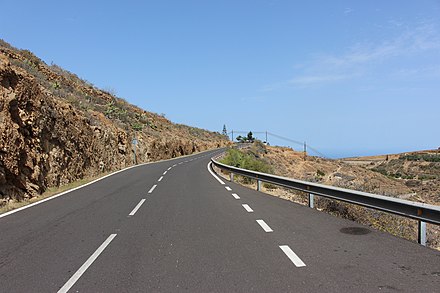 Cycling can also be a flexible and environmentally friendly way to get around the island. Tenerife is less than 100 km long, and fairly easy to explore with a city bike or mountain bike. Most of the major roads are well maintained and not too steep, although you'll need to take your time to get up El Teide if you wish to climb the volcano on a bicycle! The TF-28 for example leads from the capital Santa Cruz to Candelaria, Güímar, and all the way down to Granadilla de Abona on a nearly perfectly asphalted road surface.
Cycling can also be a flexible and environmentally friendly way to get around the island. Tenerife is less than 100 km long, and fairly easy to explore with a city bike or mountain bike. Most of the major roads are well maintained and not too steep, although you'll need to take your time to get up El Teide if you wish to climb the volcano on a bicycle! The TF-28 for example leads from the capital Santa Cruz to Candelaria, Güímar, and all the way down to Granadilla de Abona on a nearly perfectly asphalted road surface.
By thumb
With many tourists around in their rental car, it can be quite easy to catch a ride in remote places. Hence, it is often no issue to get out of the Teide valley or other nature parks. Also locals are happy to take people for the short ride.
Inside of towns or cities you will be less lucky, but if you walk somewhere where there is obviously just one direction to go, you won't have many problems finding a ride.
On foot and navigation
Tenerife has many interesting sights and trails within its variety of nature environments. For reliable maps and comprehensive trails, a good deal of sights and tourist attractions, and general map information, consult OpenStreetMap, which is also used by this travel guide, and by many mobile Apps like OsmAnd or Mapy.cz. Or just download the according GPX or KML files (for your app) through Waymarked Trails for such trails on OpenStreetMap.
See
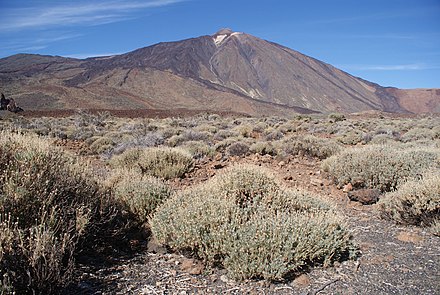 For an island less than 100 km long, Tenerife boasts as surprising variety of landscapes, biomes, and climates. Thanks to the climate altering effects of its volcanic mountain ranges, hot arid climates in the south transition to wet and cool climates in the north and east of the island. This makes Tenerife a formidable holiday destination, because visitors are rewarded with many different views without having to spend considerable time travelling.
For an island less than 100 km long, Tenerife boasts as surprising variety of landscapes, biomes, and climates. Thanks to the climate altering effects of its volcanic mountain ranges, hot arid climates in the south transition to wet and cool climates in the north and east of the island. This makes Tenerife a formidable holiday destination, because visitors are rewarded with many different views without having to spend considerable time travelling.
Nature
Unsurprisingly, much of the appeal of Tenerife comes from its numerous natural treasures. Almost a third of the islands area is protected and well preserved. It is an island of contrasts. The northern and eastern regions of the island are green and covered with forests and banana plantations alike, with flowers in every imaginable colour blooming almost around the year. The charms of the misty forests and lush vegetation make the northern half of the island a paradise loved by millions of visitors every year. The southern region of Tenerife has a very arid and hot climate, and most of it is a desert landscape with little vegetation aside from cacti, woody shrubs, and countless wind turbines. This vast region is sparsely populated and has little to offer to tourists except the brutal hardships of its desert climate, and the fauna and flora that have adapted to it.
Of particular interest are the following national and nature parks:
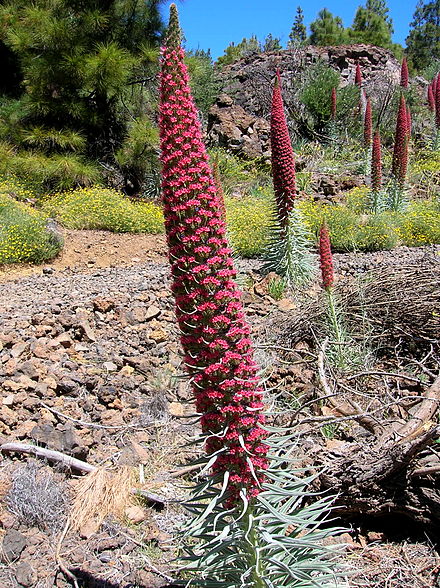
- Teide National Park – Best known for volcano El Teide (3,715 m) at its heart, surrounded by desolate landscapes of lava rock. El Teide is not only the highest mountain on the Canary Islands but in all of Spain. Over 4 million visitors are attracted to the volcanic landscapes of Teide National Park annually, making it the most visited national park in Europe. The park occupies the entire interior of the island, and is a . The breathtaking volcanic landscape with black lava rocks are worth the journey up the mountain which takes around 90 minutes from La Orotava or Vilaflor. Travelling up the summit by cable car 📍 or hiking offers a fantastic view of Tenerife and neighbouring islands provided there are no clouds. It is also one of the best locations on the planet to observe the sky, and a visit to the Teide Observatory is a highlight of any visit for astronomy enthusiasts. There is a free visitor centre for Teide National Park in La Orotava that is worth a visit.
- Anaga Rural Park – Covers 140 km² in the north-east of the island and has been a Protected Biosphere since 2015 because it is home to the largest number of endemic species in Europe. It is best known for its mist forests, and numerous tiny villages that have largely preserved their historic life style.
- Teno Rural Park – On the opposite side of Tenerife, covering most of the western tip of the island. It has a mountainous landscape abruptly ending in the ocean with tall cliffs called Los Gigantes. The best known settlement in the park is Masca, the islands most picturesque village.
- Corona Forrestal Natural Park – Covers large swaths of forest of Canarian pine trees on the slopes of El Teide, and is with an area of 410 km² the largest protected area on the Canary Islands. It stretches from an altitude of 300 m up to 2,715 m.
Volcanic activity has also created some of the largest volcanic cave systems, the Wind Cave](https://cuevadelviento.net/en/home/?lang=en) near Icod de los Vinos. With a length of 17 km it is the largest system in Europe and 5th in the world, after those of Hawaii. A tour around the cave takes visitors into the heart of the volcano. Places are limited so make sure to book tickets online well in advance.
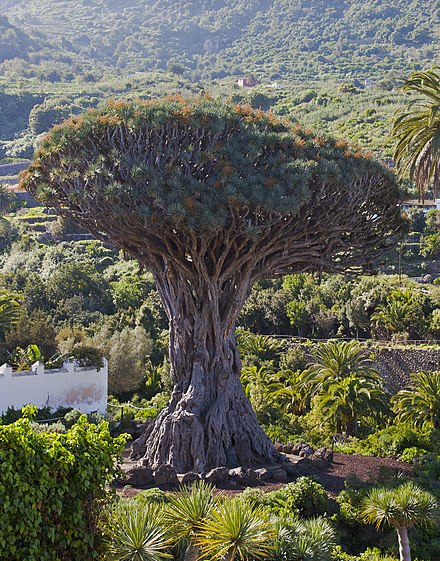 Tenerife is home to hundreds of endemic species of fauna and flora, including beautiful flowers such as the bright red Echium wildpretii only found on El Teide, lizards, birds, and cacti. Among the most recognizable ones are drago trees, which can grow up to several hundreds of years old. The most famous one is the Drago Milenario in Icod de los Vinos, said to be over a thousand years old and one of the symbols of Tenerife since it became a national monument in 1917. Drago tree seeds can be purchased in many gift shops on the island, offering the chance to take home a unique live souvenir without harming the islands natural beauty.
Tenerife is home to hundreds of endemic species of fauna and flora, including beautiful flowers such as the bright red Echium wildpretii only found on El Teide, lizards, birds, and cacti. Among the most recognizable ones are drago trees, which can grow up to several hundreds of years old. The most famous one is the Drago Milenario in Icod de los Vinos, said to be over a thousand years old and one of the symbols of Tenerife since it became a national monument in 1917. Drago tree seeds can be purchased in many gift shops on the island, offering the chance to take home a unique live souvenir without harming the islands natural beauty.
The variety in foliage resulting from Tenerife's many different climates is easily recognizable by the many species of trees that can be seen growing in the wild. Canary pine trees, drago trees, and the iconic Canary palm trees are examples of flora unique to the archipelago. All of the endemic palm tree species, complemented by dozens of exotic species, are on display in the Palmetum in Santa Cruz. The park is in the heart of the capital, and a must see for nature lovers. It features different biomes for palm trees, ranging from arid to an entire artificial rain forest, and offers fantastic views over the ocean and the city itself.
Much of Tenerifes wildlife is difficult to observe in the wild for tourists, especially aquatic animals roaming the oceans. A recommendable alternative is Loro Parque, regarded as the best zoo in the world in 2018 and with 40 million visitors annually the most popular attraction on the archipelago. Loro Parque was established in the 1970s as a paradise for parrots, and has since grown into a sanctuary for fauna and flora including over 4,000 parrots of 350 different species. It is also home to dolphins, sea lions, and orcas, the largest indoor penguin exhibition in the world, a massive aquarium with shark tunnel, and an orchid garden with numerous rare orchid species.
Culture
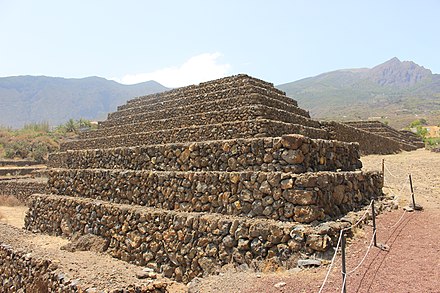 In addition to its natural treasures, the island also has many architectural and cultural highlights. Tenerife has a long history dating back 2 millennia when the first settlers arrived from North Africa. These Guanche cave dwellers left many artifacts and structures, and many of their cave homes are still inhabited today in the southern regions of the island where they are a cooler alternative than above ground habitation. Some of the most remarkable remains predating Spanish colonisation are the stepped pyramids in the Ethnographic Park of Güímar, the most popular archaeological site on Tenerife. Just like their counterparts in Egypt or Latin America, the origin of the pyramids has been the subject of scientific debate, and the museum presents the hypotheses as a series of interactive exhibits. The 6 stepped pyramids and the museum are well worth a visit.
In addition to its natural treasures, the island also has many architectural and cultural highlights. Tenerife has a long history dating back 2 millennia when the first settlers arrived from North Africa. These Guanche cave dwellers left many artifacts and structures, and many of their cave homes are still inhabited today in the southern regions of the island where they are a cooler alternative than above ground habitation. Some of the most remarkable remains predating Spanish colonisation are the stepped pyramids in the Ethnographic Park of Güímar, the most popular archaeological site on Tenerife. Just like their counterparts in Egypt or Latin America, the origin of the pyramids has been the subject of scientific debate, and the museum presents the hypotheses as a series of interactive exhibits. The 6 stepped pyramids and the museum are well worth a visit.
The Guanche aborigines also had burial rites involving mummification of their dead, and numerous mummies have been found by archaeologists across the island such as in the Barranco de Badajoz. Many are on display in the Museum of Nature and Archaeology in Santa Cruz.
Spanish colonisation in 1496 brought cultural revolution to Tenerife, as Spanish settlers began construction of towns and cities that mirrored their homeland. Historic architecture is easily recognizable as Spanish, with several unique Latin America touches in its finishing. The historic capital city San Cristóbal de La Laguna 📍 is a with a completely pedestrianized historic centre. It is a paradise for architecture enthusiasts with well preserved religious and residential masterpieces concentrated in a handful of streets. The many estates, belonging to early conquistadores, have beautifully restored facades and inner courtyards that are often open to the public. The renovated Casa Salazar is one of the finest examples, completely erected in cut volcanic rock. The cathedral in a Spanish colonial style has been transformed in a museum of religious art, complete with audio guide. Taking a walk down the Calle San Agustín gives a fair impression of what life in a colonial city must have been like. For those less interested in history and architecture, the Museum of Science and Cosmos is only a few tram stops away from the historic centre, has a radio telescope and planetarium, and is one of the few indoor attractions in the event of rainy weather.
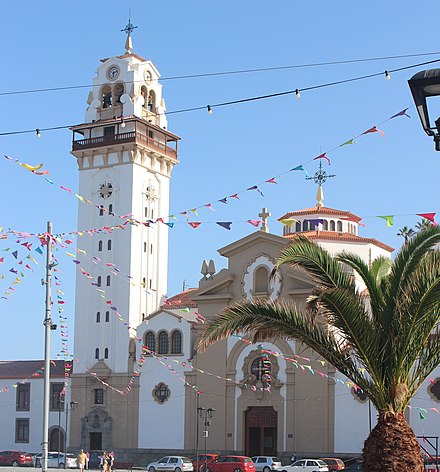 Catholicism introduced by the Spanish colonists gave rise to countless chapels and churches on Tenerife, and nearly ever village, town or city has one or more that are worth visiting. The most spectacular of all is the Basilica of Candelaria, which looks out over the Atlantic Ocean, and is an attraction that should not be missed. The Basilica receives over 2.5 million visitors annually and is the most prominent tourist attraction in the southern region of Tenerife. The square in front of the basilica is decorated with bronze statues of each of the Guanche kings. Each February it is the scene of an elaborate parade with historic fancy dresses empowered by the locals, which has also spread to Santa Cruz and San Cristóbal de La Laguna. It is said to be the third largest carnival scene after Rio de Janeiro and Notting Hill.
Catholicism introduced by the Spanish colonists gave rise to countless chapels and churches on Tenerife, and nearly ever village, town or city has one or more that are worth visiting. The most spectacular of all is the Basilica of Candelaria, which looks out over the Atlantic Ocean, and is an attraction that should not be missed. The Basilica receives over 2.5 million visitors annually and is the most prominent tourist attraction in the southern region of Tenerife. The square in front of the basilica is decorated with bronze statues of each of the Guanche kings. Each February it is the scene of an elaborate parade with historic fancy dresses empowered by the locals, which has also spread to Santa Cruz and San Cristóbal de La Laguna. It is said to be the third largest carnival scene after Rio de Janeiro and Notting Hill.
Less famous than San Cristóbal de La Laguna is La Orotava 📍, a very stately historic city on the slopes of El Teide. La Orotava has a wealth of attractions to offer to those prepared to explore its narrow and steep streets, such as Casa de los Balcones, a small museum housed in an estate mansion dedicated to the life style in Tenerifes colonial era. And there is no better place to rest out after another day in paradise than having a barraquito in the lounge sofas of nearby Casa Lercaro!
Do
Beaches
The volcanic nature of the island of Tenerife meant that the land has few natural beaches. Those that exist are characterised by black sand created from the island's volcanic rocks. The demand for tourist sun-bathing space, however, has led to the creation of resorts and man-made beaches, with golden sand having been imported in some cases.
Some of the best beaches of Tenerife are in the west, Los Gigantes, Playa San Juan 8 km south and Playa Abama just another kilometre south. Also, there is Fañabe, in the south with its golden sand, showers and excellent facilities. Also popular are Torviscas with its marina, Playa de las Américas for its grey blackish sandy stretches and Los Cristianos' yellow imported sand beach. Candelaria in the east has a small black shingle beach. Up north Puerto de la Cruz has a beach with fine black sand, and at Santa Cruz' golden sand has been imported for its Terasitas beach from the Sahara.
Beaches often have sun-loungers with parasols available to hire for the day, but if you are doing this for a few days it is probably better to just buy a parasol and some beach mats.
Diving
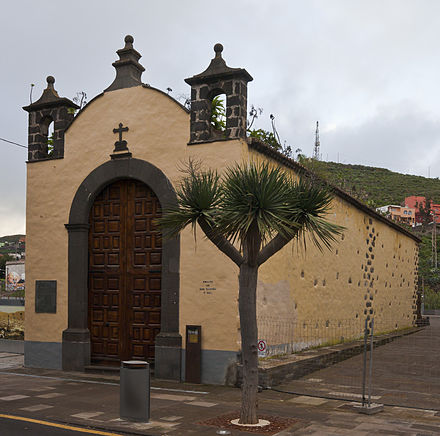 Tenerife has numerous scuba-dive operators. The seas are diveable all year, with temperatures from 18°C in January to 25°C in August. Go around the harbour wall in Puerto de la Cruz for fantastic volcanic rock formations, or feed the stringrays at Las Galletas for something a bit different.
Tenerife has numerous scuba-dive operators. The seas are diveable all year, with temperatures from 18°C in January to 25°C in August. Go around the harbour wall in Puerto de la Cruz for fantastic volcanic rock formations, or feed the stringrays at Las Galletas for something a bit different.
El Condesito is a vessel that sank near Las Galletas on the south coast of Tenerife and is now a popular dive site. The deepest point of the wreck is at 21 m and the shallowest at 6 m. Visibility can exceed 35 m. The hull, engine room and cabin used to be intact with only the bow having been torn away. Shoals of sardines may be seen at the top of the wreck, and large trumpetfish are often found around the propeller. It is not uncommon to spot barracuda, red sea stars, rays, octopus and eels within the wreck. There is a 36 m drop off nearby which is often dived by more experienced divers to see black coral before ascending to the El Condesito to decompress.
Other water activities and boat tours
- Those available include surfing, wind surfing, kayaking, speed boat parasailing and jet-ski.
- A large number of companies offer boat trips for tourists, varying from a 'booze cruise' on a cruiser offering lunch, drinks and watersports to a trip around the island on a sailing boat or catamaran. One of the main attractions is the chance to see whales and dolphins in the wild. Visitors on most trips spot whales; dolphins are not so much of a certainty but can be seen generally—often very close to the boat. Whale and dolphin watching trips run near from either Puerto Colon in Playa de las Américas, from the port at Los Cristianos, and from Los Gigantes. Most operators offer a free bus service from the larger hotels in the main resorts.
- The Canary Islands are one of the best spots in the world for big game fishing and a number of companies offer fishing trips in Tenerife. While blue marlin are the most highly prized trophy fish there are plenty of other species including white marlin, wahoo, dorado, yellowfin tuna, and mako and hammerhead sharks. Regular catches of blue marlin range from with last year's record standing at . Trips cost around €45 including all equipment, but excluding lunch.
Hiking
Even though La Gomera is know by many for its great hiking, the variety offered by Tenerife can easily outmatch La Gomera. Tenerife is an excellent destination, and there are routes for everyone, from leisurely one hour strolls to extremely strenuous full day hikes with 2,000-3,000-m ascents or in demanding terrain with either a huge ascent, descent or both. There are several books describing hiking routes, but another option is using Openstreetmap and Wikiloc or various other mapping services as a guide—of course it always helps to align with other enthusiastic hikers.
These are the most interesting hikes:
- Teide and/or Pico Viejo – A demanding hike that requires a little preparation, even if it's just mentally. Beside that, the crater offer various other hiking opportunities reachable by bus or car and doable on a smaller scale.
- Anaga Rural Park — A rain forest that can easily compete with La Gomera, and a fantastic place to go hiking with numerous destinations.
- Masca valley – Restricted to a few hikers with permit. Starting at Masca village, going down all the way to a beach, in-between massive cliffs. Taking the hike uphill requires at least water supplies, in case of high temperatures. There is also a boat option available to reach to foot of the canyon.
- Teno Rural Park – Includes many hikes through pristine forests, and highlights like Masca and Punta de Teno, the most western point with excellent views, with a lighthouse. Risco Verde is a must for an unforgetable sunset above the Masca village and gorge.
- Los Gigantes – A hiking hub for numerous destinations into the surround region, with the marvelous Los Gigantes cliffs right in front of it, and Masca and Teno Rural Park around the corner.
- Ventanas de Güímar – An impressive hike through water tunnels along a almost vertical cliff at 1,000 m altitude above Güímar—definitely not a destination for people suffering from vertigo.
- Bosque de Esperanza – A paradise for hikers, the forest is both mysterious and untouched by mass tourism. Its narrow mountain roads, great hiking trails, twisted fairytale woodland landscape, and breathtaking views are worth a visit on their own.
- Paisaje Lunar – Allows for a easy–medium difficult hike from Vilaflor to the so-called moon landscape.
- Roque del Conde – One of the most prominent mountains on the south coast. A few hours hike from the nearby Arona or Vento (meaning wind) villages, it goes through a relatively big canyon of Barranco del Rey and at top provides great views to all sides (unless mist builds up).
Climbing
Villa de Arico is the climbing capital of the island with two hostels catering for international climbing enthusiasts. There is a local climbing shop for all necessary equipment and numerous climbing routes in close range of the town, like along the Barranco La Puente just behind the town. Check out Tenerife Climbing House and Base Camp Ortiz for more details.
Get some professional advice before heading out anywhere for climbing. The rocks on the Canary Islands are very sharp, even the sandy ones. Some people have lost their finger tips due to going out too carelessly. Loose rocks and boulders can also be a problem within the local environment.
Cycling
Tenerife attracts a large number of cyclists all year around. Whether mountain biking or road biking, Tenerife has plenty of beautiful roads and dirt tracks. If you want to avoid the hassle of bringing your own bike, you can rent bikes on the island, for example in Las Americas, El Médano or Puerto de la Cruz.
Cycling is hard to do casually although bikes are available to rent. The coastal roads are busy and there is little room for bikes except often in the gutter. However, if you like cycling up hills there are plenty of steep roads to climb as soon as you leave the coastline. For those less fit, one tour company offers a car trip to the top of El Teide with a cycle down, no pedalling required.
One popular MTB route is the Canal de Vergara track, which follows the probably longest water canal on the island around Teide on about 1,500–1,000 m altitude, starting from above La Guancha.
Venues
-
Loro Parque – Home to the world’s most important Parrot collection (Parrot Park) with over 300 species, an amazing seal show, Dolphin Show, Parrot Show, Aquarium with Shark tunnel, Gorillas, Chimpanzees, Tigers, Jaguars, Flamingos, Alligators, Tortoises, Orchid House, Gambian Market, a 'NaturaVision' Cinema and the worlds largest Penguinarium with a reproduction Antarctic climate within which 12 tons of snow falls a day. Great for kids, terrible for animals.
-
Siam Park – Opened in 2008, this is a fantastic water park, created by the owners of Loro Parque. It has been beautifully designed, like a modern Lago Martianez! Look out for the 2-m high artificial waves. Also, check the ratings so you know what to expect, there are high times when you wouldn't want to go.
-
Tenerife Auditorium – An incredible building in Santa Cruz designed by the famous Spanish architect Santiago Calatrava. It is highly recommended to tourists to visit this incredible structure and even to enjoy any of the concerts and events held in it.
Buy
Money
See Canary Islands#Money for more information on cash, ATMs and credit cards.
Shopping
Santa Cruz has a big market by the station on Sunday mornings, and a local picturesque market Mercado Municipal Nuestra Señora de África (open daily until 14:30). Las Americas has one Thursdays and Saturdays and Los Cristianos on Sundays and Tuesdays.
Opening hours can vary considerably between different places and types of shops. While most supermarkets and shopping centers stay open throughout the day, many smaller shops close for a couple of hours in the afternoon – especially in the less touristy areas. Most stores are closed on Sundays and bank holidays, with certain exceptions in tourist hot spots.
Keep in mind that almost all goods with the exception of fish and fruits must be imported, so buying clothes or electronics is neither economical nor ecological. In addition, the quality of hardware such as cameras and binoculars sold in gift/souvenir shops or by street vendors is questionable.
Eat
A good summary of Canarian food can be found under Canary Islands#Eat.
Local taverns are called guachinches, typical for the Canarias and particularly common on Tenerife and Gran Canaria. They serve their own wine accompanied by homemade traditional food, often grilled fish or roasted meat. Stews of all kinds are very common and only cost a few euros for a portion. This blog keeps an overview of the best guachinches on the island.
Fast food is becoming increasingly common on Tenerife, catering to younger demographics and tourists. Restaurants with international cuisine (India, Chinese, ...) are abundant in larger cities. Especially in the south of the island, there are plenty of restaurants serving exotic foods such as hamburgers, pizza, fries, etc. There are 15 McDonald's including some on the beaches. In touristic hotspots such as Playa de las Américas, menus are available in numerous languages ranging from English and German to Russian and some Scandinavia languages, making it very easy to choose even if you are not familiar with the local dishes' names or don't understand Spanish.
Drink
The nicest bars are found in Puerto de la Cruz, La Laguna, and in the capital Santa Cruz de Tenerife. They serve a wide variety of locally produced beers, wines, and liqueurs. The best wines also originate from the north of the island, where cultivation of the malvasia grape variety has a long tradition since export began in the 17th century. 50% of Canary wine denominations originate from Tenerife. In addition, countless wines are produced in house by guachinches in small quantities, often as mixtures of red wines with fruity wines.
Beers produced on the island are also widely available, most notably Dorada (gold) and Reine (queen), although their taste is not particularly special. Because of the size constraints (arable land) on the island, the entire production is consumed domestically, so you won't find these beers anywhere else.
The abundance of fruits also yields a variety of liqueurs and other drinks with high alcoholic content, most notably banana liqueurs.
 The coffee Barraquito (also called barraco) is a Canary specialty and very popular on Tenerife and on La Palma. It is served in a small glass, with a base of condensed milk, espresso, and a shot of Licor 43 (Cuarenta Y Tres). It is often served after the meal, finished with cinnamon and lime zest.
The coffee Barraquito (also called barraco) is a Canary specialty and very popular on Tenerife and on La Palma. It is served in a small glass, with a base of condensed milk, espresso, and a shot of Licor 43 (Cuarenta Y Tres). It is often served after the meal, finished with cinnamon and lime zest.
The south of Tenerife has a 'booze scene' reputation, with Playa de las Américas and Los Cristianos providing ample locations for those that enjoy 24 hour clubbing and drinking, with clubs charging between €10 and €25 entrance. The drinks available are the same as the rest of Europe (predominantly British) with prices being slightly less than those of continental Europe. Better alternatives are found in the north of the island, especially in La Laguna, where there are no entrance fees and drinks have a higher price/quality ratio.
Sleep
Choosing accommodation
To preserve the authenticity of its historic towns and cities, there are few hotels close to tourist hot spots — hotels like those in Calle San Agustín in San Cristóbal de La Laguna are reserved for the happy few with deep pockets. Instead, authorities have deliberately opted to build accommodation where it's less of an eye sore: in the desert in the south of the island. Unfortunately, these are very far away from the locations and attractions of interest to visitors, which are all concentrated in the northern and eastern regions of Tenerife! You'll be one or more hours (depending on whether you're travelling by car or TITSA bus) away from the nearest attraction if you accidentally get stuck in a desert town!
When booking accommodation, pay close attention to the address of the venue. Keep in mind that the entire island is administratively part of a Spanish province called Santa Cruz de Tenerife, and some hotels have been known to exploit this naming confusion to trick travelers into believing they are actually booking a bed in the city Santa Cruz de Tenerife. In reality, there is a chance you may be booking a featureless concrete room somewhere in the desert 70 km south of the capital! If the address you have been given points to a location in Los Cristianos, Playa de las Américas, or Costa Adeje, you probably want to look elsewhere unless you are on a tight budget — in which case AirB&B can offer better alternatives.
Hotels
Tenerife is an immensely popular holiday destination for many continental Europeans, and therefore hotel accommodation is in high demand. Expect to pay hefty rates for a nice room close to the historic centre of San Cristóbal de La Laguna or La Orotava. Hotels like the MC San Agustin 📍 submerge travellers in the atmosphere of a Spanish colonial city, but have only a few rooms and sell out quickly — you'll need to book months in advance and be flexible with your dates. A less glorious but more budget friendly alternative is searching for a hotel room in Puerto de la Cruz, where high rise hotel blocks were built in the 1960s and 1970s to accommodate for slob tourists. Hotel blocks like Valle Mar 📍 are incredibly ugly on the outside but rooms are surprisingly comfortable, even at discount rates if you're prepared to travel in the less popular winter season.
Another alternative is looking for hotels in smaller, less popular towns such as Tegueste, La Esperanza, or San Andrés. Accommodation there is generally cheaper, and has the added advantage of being less crowded. Those looking for a beach holiday will likely find something to taste in one of the brand new residential areas of Puertito de Güímar 📍.
Camping
Wild camping is not allowed in the National Park. However, this rule does not apply to camper vans and you can stay anywhere without issues, even at the most remote and beautiful places.
Along with a few commercial campsites, there are free communal campsites called acampadas. The acampadas are usually in the inland and above 1,000 m altitude. They often have water and toilets. To sleep at one free acampada, you have to book the night in advance on the website of the town council (cabildo). Unfortunately, the website is only in Spanish, very slow and sometimes down. However, it won't be an issue if you don't reserve, especially if the site is not overcrowded or closed.
Always remember: Take nothing but pictures, and leave nothing but footprints.
Stay safe
Around people
Pickpocketing
Tenerife is generally a safe place to visit but as always, beware of pickpockets. Do not take electrical devices, credit cards or large amounts of cash to the beach if you plan to leave your goods unattended while swimming. Take note that when walking through Playas De Las Americas, there is a lot of clubs round here and some drunkenness in the night hours. Already many mobile phones have been snatched around the islands from drunken lads, especially at night. Taxis are widely available, and not too badly priced.
Car break-ins
Masca is well known for tourists getting broken into their car and having mobiles and other valuables stolen. Thieves will even try to use stolen mobiles to extract money via credit card or other payment services. Also other crowded tourist spots are prone to such issues. Hence, never leave anything in open sight.
Scratchcard touts
If you are holidaying in Tenerife you are probably going to be approached by "scratchcard touts" whose main aim is to part you with several thousand pounds for worthless contracts for time-share apartments. This view is backed up by the UK's Office of Fair Trading who suggest that every year 400,000 UK consumers fall victim to these scams in destinations such as Tenerife, the Costa del Sol and Gran Canaria. On average each victim loses more than £3,000. Bogus "scratchcard touts" offer cards that will always be a winner, but to collect their prize, people need to attend a lengthy presentation and are persuaded into signing a contract for an "exclusive" club on the basis of false claims as to the price, range and quality of holidays available. The OFT's is advising people to ask three simple questions: can you take away the contract to consider at your leisure? Is everything you were promised in the presentation in the contract? Do you know exactly what you are getting for your money? If the answer to any of these questions is no, then simply walk away.
Electronics shops
Many, many shops on the island selling electrical and optical goods as well as cameras. You may think you are getting a bargain from these smooth talking salesmen but you aren't. You will overpay for something you could buy cheaper at home and even cheaper off eBay. Your goods may be faulty. Your guarantee will probably be worthless. These shops are everywhere in the tourist areas and so many people have been cheated by them for so many years.
Flying vendors
The other main irritant on Tenerife are the Lookey Lookey men who try to sell you sunglasses, watches, jewellery and other cheap knick-knacks known as Lucky Luckies. They are quite harmless and generally don´t mean to cause trouble, they are just trying to make a living, but a firm NO generally works!
Natural hazards

Falling rocks are a constant issue in many parts of the island, and you will often find paths, beaches or even roads temporarily or permanently closed due to the danger.
The sun is extremely strong this close to the equator so use plenty of high factor sun cream and do not sun bathe between midday and three o'clock (this is when the beaches are busiest anyway). Remember that the sun is even stronger up in the mountains, even though it may feel cool and breezy.
There are no scorpions or snakes to worry about. Mosquitoes can bite at night, especially away from the coast, but they do not carry malaria or similar diseases.
Go next
- La Gomera – A hiking center, but less diverse than Tenerife and only recommended if one cannot get enough—1 hour away by ferry.
- Gran Canaria – Second largest island, 2½ hr by ferry.
- La Palma and El Hierro – Besides La Graciosa, the most remote islands with sufficient infrastructure, also accessible by ferry, from Los Cristianos.
Tenerife
tenerife.esProvincia de Santa Cruz de Tenerife
2nd-order administrative division
Canary Islands
Primary administrative division